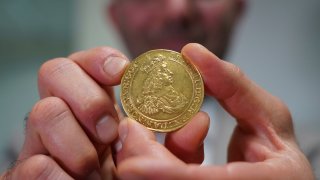
The vast coin collection of a Danish butter magnate is set to finally go on sale a century after his death, and could fetch up to $72 million.
Lars Emil Bruun, also known as L.E. Bruun, stipulated in his will that his 20,000-piece collection be safeguarded for 100 years before being sold. Deeply moved by the devastation of World War I, he wanted the collection to be a reserve for Denmark, fearing another war.
Now, over a century since Bruun’s death at the age of 71 in 1923, New York-based Stack’s Bowers, a rare coin auction house, will begin auctioning the collection this fall, with several sales planned over the coming years.
On its website the auction house calls it the “most valuable collection of world coins to ever come to market.” The collection's existence has been known of in Denmark but not widely, and it has never been seen by the public before.
Get top local stories in Connecticut delivered to you every morning. >Sign up for NBC Connecticut's News Headlines newsletter.
“When I first heard about the collection, I was in disbelief,” said Vicken Yegparian, vice president of numismatics at Stack’s Bowers Galleries.
“We’ve had collections that have been off the market for 100 years plus,” he said. “But they’re extremely well known internationally. This one has been the best open secret ever.”
Born in 1852, Bruun began to collect coins as a boy in the 1850s and '60s, years before he began to amass vast riches in the packing and wholesaling of butter.
U.S. & World
His wealth allowed him to pursue his hobby, attending auctions and building a large collection that came to include 20,000 coins, medals, tokens and banknotes from Denmark, Norway and Sweden.
Following the devastation of World War I and fearing another war, Bruun left strict instructions in his will for the collection.
“For a period of 100 years after my death, the collection shall serve as a reserve for the Royal Coin and Medal Collection," it stipulated.
“However, should the next century pass with the national collection intact, it shall be sold at public auction and the proceeds shall accrue to the persons who are my direct descendants.”
That stipulation didn’t stop some descendants from trying to break the will and cash in, but they were not successful. “I think the will and testament were pretty ironclad. There was no loophole,” Yegparian said.
Yegparian estimates some pieces may sell for just $50, but others could go for over $1 million. He said potential buyers were already requesting a catalogue before the auction was announced.
The collection first found refuge at former Danish royal residence Frederiksborg Castle, then later made its way to Denmark’s National Bank.
Denmark’s National Museum had the right of first refusal on part of the collection and purchased seven rare coins from Bruun’s vast hoard before they went to auction.
The seven coins — six gold, one silver — were all minted between the 15th and 17th centuries by Danish or Norwegian monarchs. The cost of over $1.1 million was covered by a supporting association.
“We chose coins that were unique. They are described in literature as the only existing specimen of this kind,” said senior researcher Helle Horsnaes, a coin expert at the national museum.
“The pure fact that this collection has been closed for a hundred years makes it a legend,” Horsnaes said. “It’s like a fairytale.”



